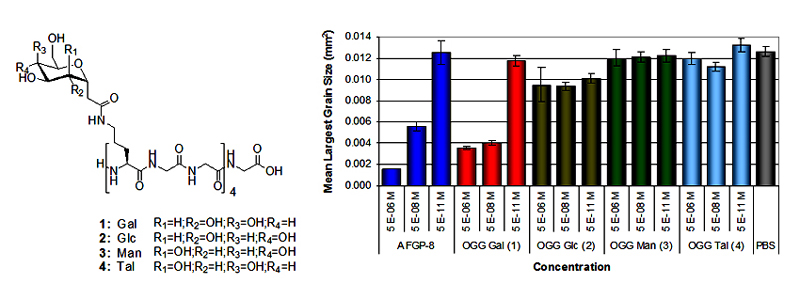Ice recrystallization inhibitors as cryoprotectants
The cellular injury resulting from freezing and thawing has been studied for the last sixty years. Toward this end, researchers have focused on identifying and understanding the nature of cell damage during cryopreservation and how damage can be prevented. It is generally accepted that cells are not damaged upon exposure to cold temperatures as previously thought. In fact, evidence suggests that intracellular or extracellular ice formation is solely responsible for the damage that cells sustain during freezing. Non-penetrating cryoprotectants are employed in an effort to dehydrate the cell and minimize the chance of intracellular ice formation. The correlation between intracellular ice formation and cell death has been recognized but evidence suggests that formation of intracellular ice does not directly kill cells. Studies have shown that survival of cells post-cryopreservation is dependant upon the rate at which the cells are warmed during thawing and that cell death associated with intracellular ice formation is not caused by the initial nucleation of ice but by an alternate process during warming. Possible mechanisms by which intracellular ice damages cells have been reviewed extensively in the literature and it has been concluded that cell death is occurring as a result of ice recrystallization. This hypothesis is supported by the fact that many freeze-tolerant organisms inhabiting sub-zero environments produce large quantities of recrystallization-inhibitors in vivo to ensure survival.
Our laboratory has reported the synthesis of several structural and functional carbon-linked (C-linked) antifreeze glycoprotein (AFGP) analogues. These complex glycoproteins possess custom-tailored antifreeze activity and are potent inhibitors of ice recrystallization. Based upon the hypothesis that hydration of a glycoconjugate is strongly influenced by carbohydrate stereochemistry, we have shown that ice recrystallization inhibition (IRI) activity is correlated to hydration.

Graph 1. IRI activity of AFGP 8, C-linked AFGP analogues 1-4 and PBS standard at -6.4 °C after 30 mins annealing time. Error bars indicate SEM.
This work has been recently been extended to simple carbohydrates and confirm that hydration is an important parameter for all inhibitors of ice recyrstallization. We are currently exploring the synthesis of novel low molecular weight carbohydrate derivatives with extreme hydration characteristics. Such compounds are highly potent inhibitors of ice recrystallization. The efficacy of these compounds as cryoprotectants is tested in cryopreservation assays using umbilical cord blood and neurons as well as several commercially available cell lines. Although cord blood is enriched for blood-forming, or hematopoietic, stem cells (HSCs), the absolute number is limited by the total volume that can be collected from the placenta and by the number of cells that survive the freezing and storage process. Improved methods of banking cord blood that allow a 15 ¨C 20% increase in the preservation of viable and functional stem cells would make cord blood transplantation more applicable in adult patients and address the growing need for alternative donor sources for these patients. In addition, the emerging field of regenerative therapy using vascular progenitors and mesenchymal stem cells from human umbilical cord blood requires more focused attention on the effects of cryopreservation and storage on these rare non-hematopoietic progenitor cells.


